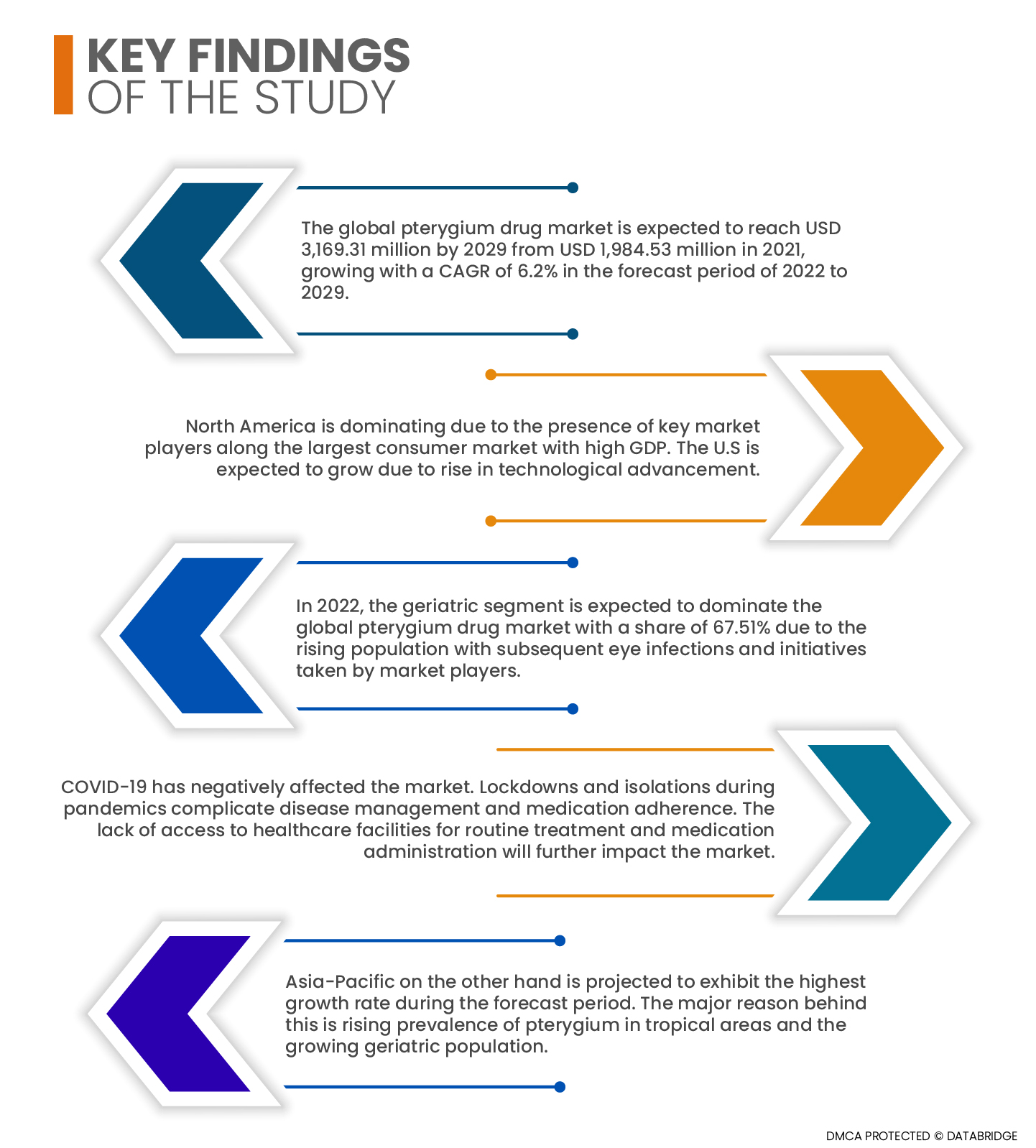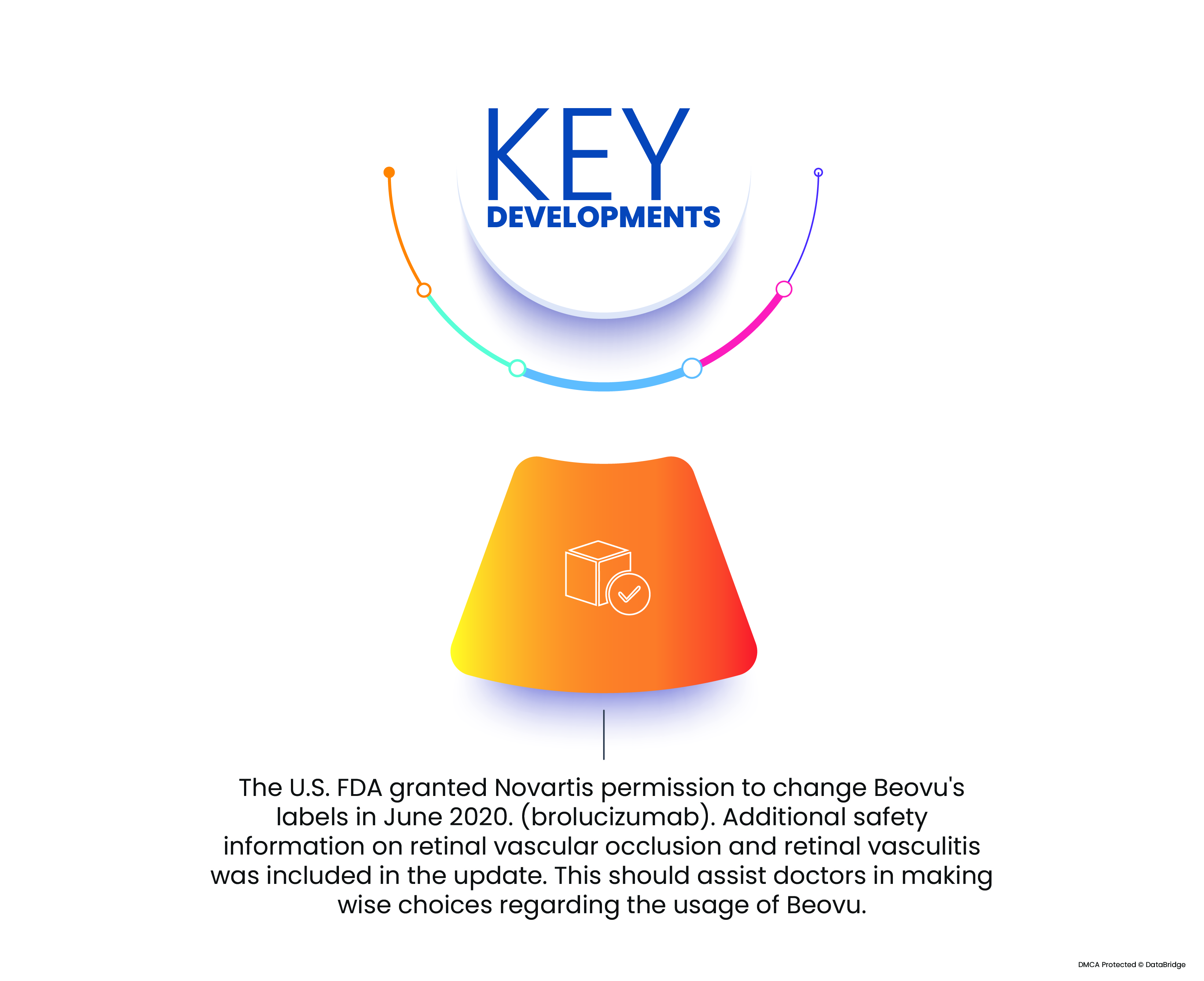The National Eye Institute (NEI) established the National Eye Health Education Program (NEHEP) to assist them in achieving one of their goals: to educate experts and the general public on the importance of eye health. NEHEP collaborates closely with health professionals and educators to develop resources and tools they may use in their communities to raise awareness.
Access Full Report @ https://www.databridgemarketresearch.com/reports/global-pterygium-drug-market
The global pterygium drug market is expected to reach USD 3,169.31 million by 2029 from USD 1,984.53 million in 2021, growing with a CAGR of 6.2% in the forecast period of 2022 to 2029. With this increasing age and rising prevalence of the ophthalmic disorder population, the demand for the proper treatment and medications is also increasing. With the growing population, the pressure on the healthcare system is expanding. The demand for care and services is rising to treat the problem of Ophthalmol disorder, including pterygium. Therefore, the increasing geriatric population is a great opportunity for the pterygium drug market.

Rising incidence and prevalence of ophthalmic disorders across the world will drive the market's growth rate
The prevalence of ophthalmic disorders keeps showing a surge in growth due to the rise in chemical industries and pollution worldwide. Chemical burns and flash burns cause significant and severe ocular pain due to irritations over the eye surface. The most common causes of pterygium include long-term exposure to ultraviolet (UV) light from the sun (most common cause) and eye irritation caused by hot, dry weather, wind, and dust. The affirmative factors state that this is the major driver for the global pterygium drugs market.
Report Scope and Market Segmentation
|
Report Metric
|
Details
|
|
Forecast Period
|
2022 to 2029
|
|
Base Year
|
2021
|
|
Historic Years
|
2020 (Customizable to 2014 - 2019)
|
|
Quantitative Units
|
Revenue in USD Million, Volumes in Units, Pricing in USD
|
|
Segments Covered
|
Disease Type (Progressive Pterygium and Atrophic Pterygium), Stages (Stage 2, Stage 3, Stage 1, Stage 4), Treatment (Artificial Tears/Topical Lubricants and Steroid Eye Drops), Formulation (Eye Drops, Eye Ointments, Others), Mode of Purchase (Prescription and Over the Counter (OTC)), Population Type (Geriatric and Adults), End User (Hospitals, Specialty Clinics, Home Healthcare, Others), Distribution Channel (Retail Pharmacies, Hospital Pharmacies, Online Pharmacies, Others)
|
|
Countries Covered
|
U.S., Canada and Mexico in North America, Germany, France, U.K., Netherlands, Switzerland, Belgium, Russia, Italy, Spain, Turkey, Rest of Europe in Europe, China, Japan, India, South Korea, Singapore, Malaysia, Australia, Thailand, Indonesia, Philippines, Rest of Asia-Pacific (APAC) in the Asia-Pacific (APAC), Saudi Arabia, U.A.E, South Africa, Egypt, Israel, Rest of Middle East and Africa (MEA) as a part of Middle East and Africa (MEA), Brazil, Argentina and Rest of South America as part of South America.
|
|
Market Players Covered
|
Johnson & Johnson Services, Inc. (U.S.), Novartis AG (Switzerland), Akorn Operating Company LLC (U.S.), Bausch & Lomb Incorporated (Canada), AbbVie Inc. (U.S.), Prestige Consumer Healthcare Inc. (U.S.), Spectra Vision Care (India), Théa Laboratories (France), Wellona Pharma (India), SAGER PHARMA (Hungary), Maya Biotech Private Limited (India), EYERIS VISIONCARE Pvt. Ltd. (India), Sylentis (Spain), Bayer AG (Germany), Zydus Group, Amneal Pharmaceuticals LLC (India), OASIS Medical (U.S.), Similasan Corporation (Switzerland), Alcon (Switzerland), and Santen Pharmaceutical Co., Ltd. (Japan) among others.
|
|
Data Points Covered in the Report
|
In addition to the market insights such as market value, growth rate, market segments, geographical coverage, market players, and market scenario, the market report curated by the Data Bridge Market Research team includes in-depth expert analysis, patient epidemiology, pipeline analysis, pricing analysis, and regulatory framework.
|
Segment Analysis:
The global pterygium drug market is categorized into eight segments: disease type, stages, treatment, formulation, mode of purchase, population type, end user, and distribution channel.
- Based on disease type, the global pterygium drug market is segmented into progressive pterygium and atrophic pterygium. In 2022, the progressive pterygium segment is expected to dominate the global pterygium drug market with a share of 73.01% due to the high prevalence of the disease, along with other factors such as old age population, and geographies among others.
- On the basis of stages, the global pterygium drug market is segmented into stage 2, stage 3, stage 1, and stage 4. In 2022, the stage 2 segment is expected to dominate the global pterygium drug market with a share of 46.98% due to the growing geriatric population.
- Based on treatment, the global pterygium drug market is segmented into artificial tears/topical lubricants and steroid eye drops. In 2022, the artificial tears/topical lubricants segment is expected to dominate the global pterygium drug market with a share of 79.51% due to higher sales of lubricant in the market.
- Based on formulation, the global pterygium drug market is segmented into eye drops, eye ointments, and others. In 2022, the eye drops segment is expected to dominate the global pterygium drug market with a share of 79.45% due to the expansion in product portfolio for symptoms of pterygium may accelerate the growth of pterygium drug market in the forecast period.
- Based on mode of purchase, the global pterygium drug market is segmented into prescription and over the counter (OTC). In 2022, the prescription segment is expected to dominate the pterygium drug market with a share of 71.19% as the most advanced, and fast healing drug are prescribed and not available as over the counter medicines.
- Based on population type, the global pterygium drug market is segmented into geriatric and adults. In 2022, the geriatric segment is expected to dominate the global pterygium drug market with a share of 67.51% due to the rising population with subsequent eye infections and initiatives taken by market players.
- Based on end user, the global pterygium drug market is segmented into hospitals, specialty clinics, home healthcare, and others. In 2022, the hospitals segment is expected to dominate the global pterygium drug market with a share of 42.68% due to rise in healthcare infrastructure.
The hospital segment will dominate the end user segment of the pterygium drug market
The hospital segment will emerge as the dominating segment under end user with approximately 61.00% market share. This is because of the growing number of infrastructural development activities in the market especially in the developing economies. Further, growth and expansion of the healthcare industry all around the globe will further bolster the growth of this segment.
- Based on distribution channel, the global pterygium drug market is segmented into retail pharmacies, hospital pharmacies, online pharmacies, and others. In 2022, the retail pharmacies segment is expected to dominate the global pterygium drug market with a share of 45.35% as they directly provide the best quality product from manufacturers.
The retail pharmacies segment will dominate the distribution channel segment of the pterygium drug market
The retail pharmacies segment will emerge as the dominating segment distribution channel segment. This is because of the growing number of retail pharmacies in the market especially in the developing economies. Further, growth and expansion of research development services on a global scale will further bolster the growth of this segment.
Major Players
Data Bridge Market Research recognizes the following companies as the market players in pterygium drug market: Johnson & Johnson Services, Inc. (U.S.), Novartis AG (Switzerland), Akorn Operating Company LLC (U.S.), Bausch & Lomb Incorporated (Canada), AbbVie Inc. (U.S.), Prestige Consumer Healthcare Inc. (U.S.), Spectra Vision Care (India), Théa Laboratories (France), Wellona Pharma (India), SAGER PHARMA (Hungary), Alcon (Switzerland), and Santen Pharmaceutical Co., Ltd. (Japan).

Market Development
- The U.S. FDA granted Novartis permission to change Beovu's labels in June 2020. (brolucizumab). Additional safety information on retinal vascular occlusion and retinal vasculitis was included in the update. This should assist doctors in making wise choices regarding the usage of Beovu.
Regional Analysis
Geographically, the countries covered in the pterygium drug market report are U.S., Canada and Mexico in North America, Germany, France, U.K., Netherlands, Switzerland, Belgium, Russia, Italy, Spain, Turkey, Rest of Europe in Europe, China, Japan, India, South Korea, Singapore, Malaysia, Australia, Thailand, Indonesia, Philippines, Rest of Asia-Pacific (APAC) in the Asia-Pacific (APAC), Saudi Arabia, U.A.E, South Africa, Egypt, Israel, Rest of Middle East and Africa (MEA) as a part of Middle East and Africa (MEA), Brazil, Argentina and Rest of South America as part of South America.
As per Data Bridge Market Research analysis:
North America is the dominant region in pterygium drug market during the forecast period 2022 - 2029
North America is dominating due to the presence of key market players along the largest consumer market with high GDP. The U.S is expected to grow due to rise in technological advancement.
Asia-Pacific is estimated to be the fastest growing region in pterygium drug market the forecast period 2022 - 2029
Asia-Pacific on the other hand is projected to exhibit the highest growth rate during the forecast period. The major reason behind this is rising prevalence of pterygium in tropical areas and the growing geriatric population.
COVID-19 Impact
COVID-19 has negatively affected the market. Lockdowns and isolations during pandemics complicate disease management and medication adherence. The lack of access to healthcare facilities for routine treatment and medication administration will further impact the market.
For more detailed information about the pterygium drug on market report, click here – https://www.databridgemarketresearch.com/reports/global-pterygium-drug-market










